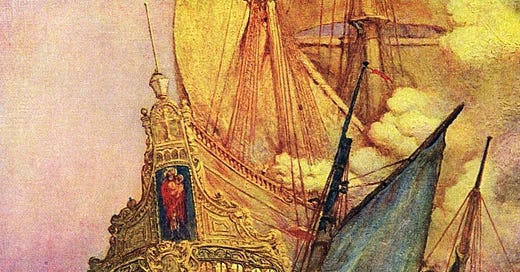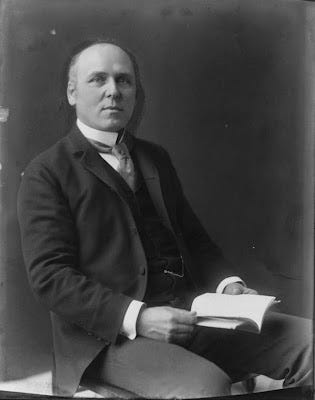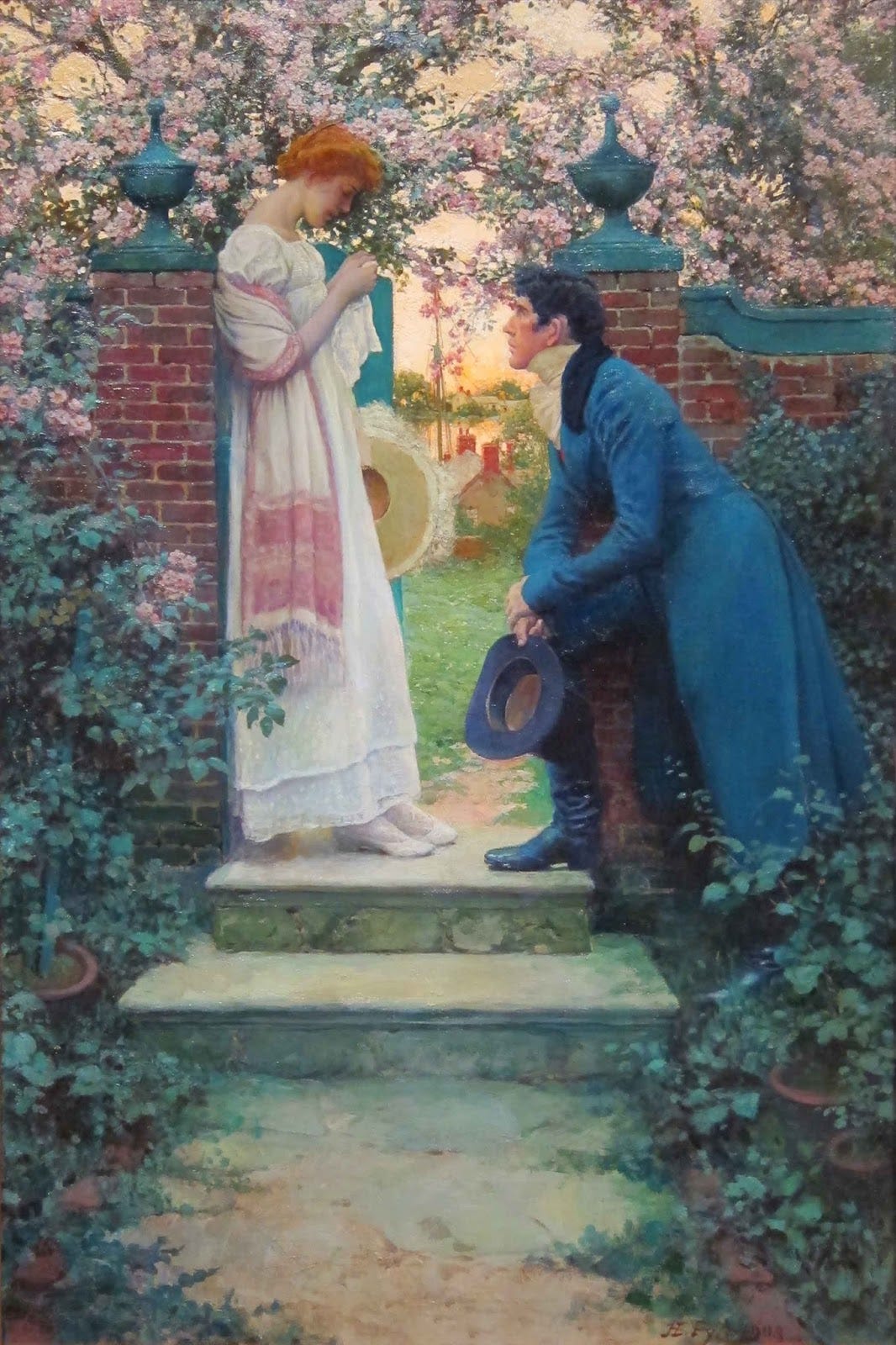Howard Pyle, Attack on a Galleon
One of Howard Pyle’s lesser-known students was a distant relative of mine named Elizabeth Keeler Gurney.* (For more on how she’s related, see the bottom of this post.)
Miss Gurney’s 1919 reminiscence of one of Pyle’s legendary composition lectures, as published in Delaware Magazine, and recounted in a recent blog post by Ian Schoenherr, is as vivid as any of the documents that have come down to us:
AN EVENING WITH HOWARD PYLE
by Elizabeth Gurney
“Did you ever hear, and feel, and smell, as well as see a picture?”
This question was asked of his pupils by Howard Pyle, the famous Delaware artist, one winter night years ago. The class, together with invited guests had assembled in Mr. Pyle’s studio, on Franklin Street, in Wilmington, for the weekly evening lecture. Its members occupied a motley, yet beautiful, collection of colonial and mediaeval chairs - big chairs, little chairs, fat chairs, thin chairs - chairs as diversified as the Pied Piper’s rats. The chairs were drawn up in prayer-meeting fashion so as to face a long row of charcoal drawings, suspended like a family washing from a clothes-line. Flanking the line, painted canvases rested against convenient chair legs. Firelight played upon the polished hardwood of floor and walls, picked out shiny lights in queer jugs and bottles upon shelves; and illumined the eager, interested faces of the group of young women and men, mostly young men.
Carven ships’ figures, Venetian treasure chests, a piratical array of antique pistols and knives, bits of drapery, and easels, surrounded the group. Above them hung curious lanterns and many ropes ending in wooden balls. The ropes, when pulled, shifted skylight curtains; but how Mr. Pyle could ever tell what rope worked which curtain was a never-ending marvel to his pupils.
In the semi-darkness of an adjoining room some of the artist’s paintings could be dimly seen against the walls. Through gabled windows shone frosty, blue moonlight, accentuating the golden warmth within, and blackly silhouetting a few ivy leaves which had strayed across the windows from the mass thickly curtaining the outside brick walls.
Between pupils and drawings stood the tall figure of Mr. Pyle, massive of head. A pupil once remarked that with the addition of a powdered wig, Howard Pyle could have posed for a portrait of George Washington. The two men were not unlike in character. Great souled and kindly hearted, they possessed a personal dignity, even austerity, which did not unbend except in the presence of intimates. The artist’s pupils were greatly amused by an article in a current magazine describing the children of Wilmington as running up to Mr. Pyle, on the street to see what he had in his pockets! This Puritan dignity was marked in the artist’s paintings. His Spanish dancers were not sensuous; his oriental maidens were never voluptuous.
Mr. Pyle, his students, and his guests were surveying a sketch of salt marshes when he repeated his question.
“Do you consciously use all your senses to feel the reality, when composing or looking at a picture?” He made the class feel the dampness of the marshes upon their cheeks and the warmth of the sunshine; he made them hear the rustle of the breeze among the reeds, the sons of unseen birds, the lowing of invisible cattle; he made them fill their nostrils with the salt fragrance of the marshland; its brine was upon their lips. When he had finished, the class were not looking at a drawing, but were exploring vast stretches of moor with illimitable sky overhead.
“That is the value of pictures to make us feel life and truth!” he exclaimed. “Respect the truth,” was his most frequent admonition. He taught that an artist must have reality, not a picture, in his mind, when he put brush to canvas. He must mentally see real mountains in all their bigness if he would paint a picture that would make the beholder feel the grandeur of mountains. When the artist’s mind began to see a small painting of mountains instead of real mountains, when he began to think about his paints, or his technic, or himself, at that moment his work became artificial and without value, in the opinion of Howard Pyle.
“When I was painting this picture of a battle,” he told the class, referring to a Civil War scene now in the State Capitol of Minnesota, “I felt the reality so vividly that I had occasionally to go to the door of the studio and breathe fresh air to clear my lungs of the powder and smoke.”
Mr. Pyle passed down the line of compositions, commenting vigorously.
“These are not real trees - they are only paint. A bird could not fly through the foliage without getting tangled up in the paint. The moon could not possibly be as large when so high above the horizon, and it would not be that color at the time of year indicated by the painting. Here is a man in a blizzard. Why is there no snow on his shoulders? Why is he not huddled-up as a man would be in the cold? Here is a laborer, digging in a trench. His muscles are not straining under the effort. Although he has worked at this job for some time, his clothes are as clean and unwrinkled as if they just were new from the shop. In this colonial picture, you do not feel that these people’s clothes are their usual attire. They wear them as stiffly and the clothes are as little wrinkled as if these were people at a fancy dress ball.”
The speaker paused and surveyed his audience reproachfully.
“You all know better. Why do you put falsities into your pictures when you recognize them as such the moment I point them out? Simply because you don’t think. Anybody can learn to draw. It is ease to draw, but it is very difficult to think. You haven’t material with which to think because you are all blind. Most people are blind. They don’t really see what is around them. Mention some building they have seen a hundred times. They cannot give an accurate description of it from memory. Store your mind richly by cultivating your observation.”
Howard Pyle, When All the World Was Young
Mr. Pyle pointed an eloquent finger at his pupils. “A blade of grass. When I said that, did you see anything more in your mind than a green spear of grass?”
That was exactly what the class had seen. They shifted about guiltily in the mediaeval chairs, which promptly retaliated by prodding them in the ribs with unexpected knobs and corners. Mediaeval chairs were never intended to be sat upon. Probably more than one war of the Middle Ages was due to the soreness of body and temper of some king who had been oblige to spend the morning upon a mediaeval throne while his more fortunate courtiers could stand. However, being artists, Mr. Pyle’s pupils loved to sit in the mediaeval chairs because of their beauty.
“You ought,” continued the master, “to see that grass-blade pearled with dewdrops, waving gently in the wind, and a little red lady-bug struggling up its length.”
Perhaps because most of the drawings were in black and white, Mr. Pyle’s attention was now attracted to a Biblical subject in full color. It depicted the angel descending to touch the pool, whereupon the first infirm person to be lowered into its waters would be healed.
“There is much of value in this composition,” remarked the lecturer, with an approving smile to the happy young woman who had painted it. “But I seem to feel too much darkness and discouragement about it. I feel that all these poor, sick people would be bathed in the glory of light and hope shed upon them by the great angel of their redemption.”
“Gosh!” forcibly, if not elegantly, exclaimed the young woman artist to a friend after the lecture, “I painted that composition for a class in my art school in Chicago. The teacher there said that the light and shade were not well balanced. He recommended more white paint for the upper right-hand portion. His criticism left me cold. I brought the picture tonight to see how his criticism would compare with Mr. Pyle’s. The two criticisms mean much the same thing as far as the paint is concerned, but Mr. Pyle’s criticism is the one that inspires me. I want to go right home and finish that picture tonight!”
What happens next as Pyle grabs a piece of charcoal is a classic example of his teaching style:
Keep reading with a 7-day free trial
Subscribe to Paint Here to keep reading this post and get 7 days of free access to the full post archives.







